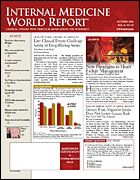Publication
Article
Internal Medicine World Report
Vitamin D Content of Fish Varies Greatly
Author(s):
Differences Exist Within and Between Types
PHILADELPHIA—Fish lovers may be upset to learn of new data presented at the American Society for Bone and Mineral Research meeting showing a significant variation in the vitamin D content of different fish consumed daily in this country; these findings also indicate that the current food charts may need to be updated, researchers say.
The US Department of Agriculture food chart suggests that there is 400 to 700 IU of vitamin D in 3.5 ounces of salmon. Salmon has been touted for some time as being one of the best food sources for vitamin D.
However, after testing samples of 24 farm-raised salmon and 20 salmon caught in the wild, farmed salmon was found to contain only about 25% of the vitamin D content of wild-caught salmon. It appears that the farm-raised salmon have less vitamin D in their edible flesh because of the lack of vitamin D in their food.
The investigators also determined that the vitamin D content of farmed trout, bluefish, and swordfish was about <50% of that of wild-caught salmon. Cod, grey sole, haddock, squid, and clams had <10% of the vitamin found in wild-caught salmon.
It is currently recommended that all adults who do not get sunlight exposure consume 1000 IU/day of vitamin D in the form of food or vitamin supplementation.
Lead investigator Michael Holick, MD, PhD, said these results demonstrate the high variability in the vitamin D content of fish and the need to update the current dietary tables.
Dr Holick suggests that physicians should advise their patients that wild-caught salmon is a much better source of vitamin D than farm-raised salmon.
But an unexpected problem may affect patients’ preferences. Several US environmental organizations have suggested that the decreasing number of salmon in the wild is directly related to excessive human consumption of the fish and have been urging people to switch from wild fish to farm-raised salmon and several other types of popular fish.
Thus, some of your patients may be reluctant to switch to wild salmon; recommending vitamin D in the form of supplements is a viable alternative.
Vitamin D is stable when heated, so it retains its viability when a food is broiled, baked, or microwaved. However, because vitamin D is an oil-soluble compound, about half of the vitamin D content is lost when fish are cooked in oil.





